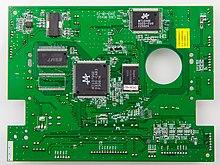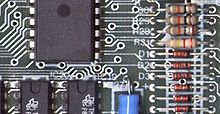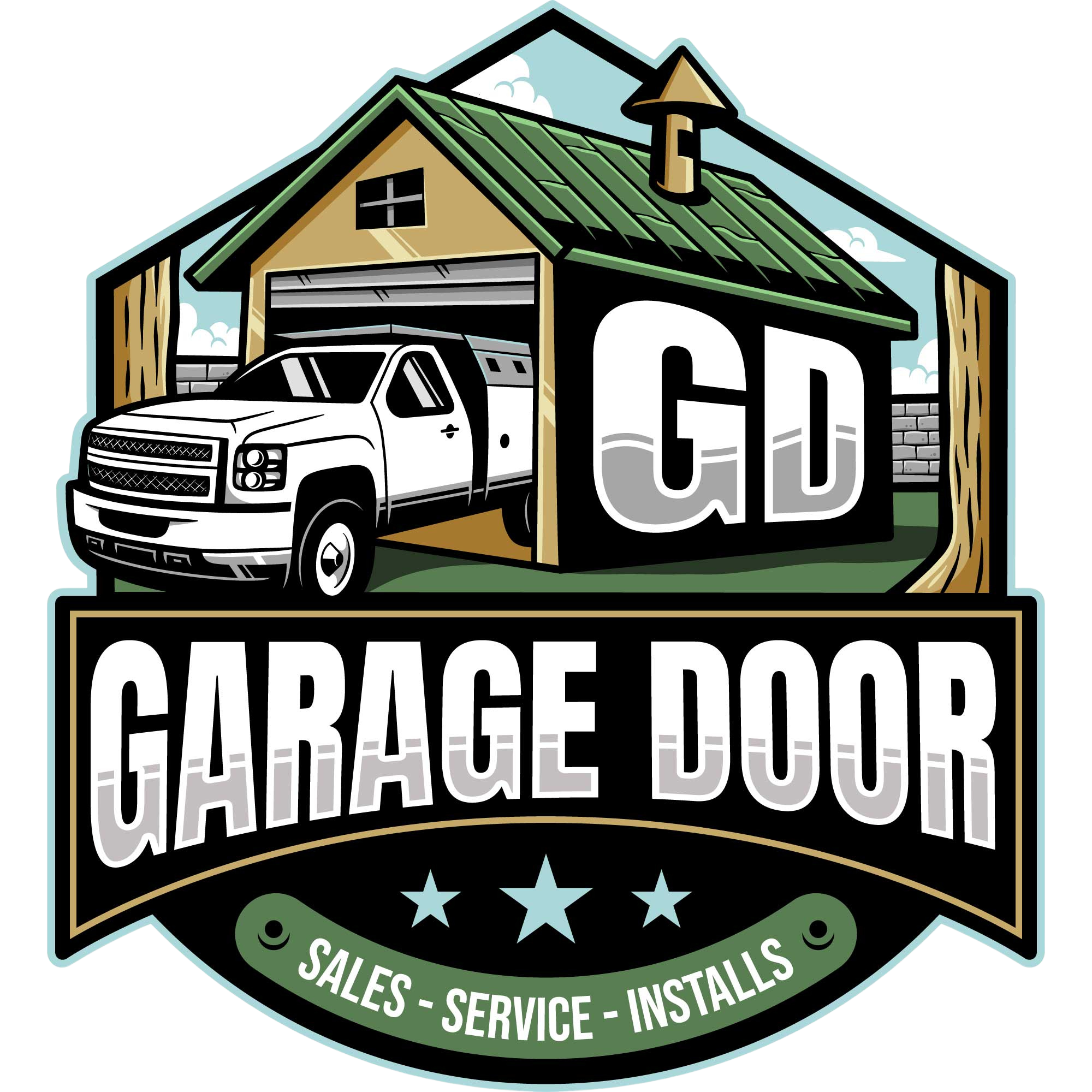Printed circuit board
Definition and Components of a Printed Circuit Board
– A printed circuit board (PCB) is a medium used to connect or wire components in a circuit.
– It consists of conductive and insulating layers laminated together.
– Conductive layers are designed with traces, planes, and features etched from copper sheets.
– Electrical components are fixed to conductive pads on the outer layers.
– Vias are plated-through holes that allow interconnections between layers.
Advantages and Alternatives of Printed Circuit Boards
– PCBs are used in nearly all electronic products.
– They require additional design effort but can be automated for manufacturing and assembly.
– Mass-producing circuits with PCBs is cheaper and faster compared to other wiring methods.
– Wire wrap and point-to-point construction are alternatives to PCBs, but they are rarely used now.
– PCBs can be single-sided, double-sided, or multi-layer, allowing for higher component density.
History and Development of Printed Circuit Boards
– Before PCBs, circuits were wired point-to-point on a chassis, making the products expensive.
– Development of modern PCB methods started in the early 20th century.
– Inventors like Albert Hanson, Thomas Edison, and Arthur Berry contributed to PCB technology.
– John Sargrove’s Electronic Circuit Making Equipment (ECME) sprayed metal onto a plastic board.
– PCBs were used on a large scale during World War II to make proximity fuzes.
– The printed circuit was invented by Paul Eisler in the UK around 1936.
– Multi-layer PCBs were used in German magnetic influence naval mines in 1941.
– The Centralab Division of Globe Union developed a viable PCB process for proximity fuzes.
– Harry W. Rubinstein received recognition for his contributions to printed components and conductors.
– PCBs represented a step in the development of integrated circuit technology.
– Printed circuits became commonplace in consumer electronics in the mid-1950s.
– The Auto-Sembly process, developed by the US Army, contributed to the adoption of PCBs.
– Motorola was an early leader in using plated circuits in consumer electronics.
– Hallicrafters released its first foto-etch printed circuit product in 1952.
– PCBs were introduced to reduce the size, weight, and cost of circuitry in electronic devices.
Recent Advances in PCB Creation
– 3D printing allows for layer-by-layer printing of PCBs.
– Liquid ink with electronic functionalities can be used in 3D printed electronics (PEs).
– HDI technology enables denser designs and smaller PCBs with more traces and components.
– HDIs use blind/buried vias and microvias for interconnections.
– HDI technology is commonly used in computer, mobile phone, medical, and military equipment.
Composition and Properties of PCBs
– PCB consists of an insulating material and a layer of copper foil.
– Chemical etching divides the copper into tracks, pads, vias, and conductive areas.
– Solder resist or solder mask protects the copper and prevents solder shorts.
– Photoresist is used for etching the copper based on the artwork pattern.
– FR-4 glass epoxy is the most common insulating substrate used in PCBs.
– PCBs can have multiple layers of copper arranged in pairs.
– More layers allow for better routing options and signal integrity control.
– Two-layer PCBs are the simplest to produce, while four-layer boards offer more routing options.
– Multi-layer boards have alternating layers of copper and substrate, with plated-through vias.
– Inner copper layers are protected by adjacent substrate layers.
– Through-hole and surface mount methods are used for mounting components.
– Through-hole components have wire leads passing through the board and soldered to traces.
– Surface mount components are attached by their leads to copper traces on the same side.
– PCBs may use both methods for mounting components, but through-hole mounting is now uncommon.
– Surface mount technology allows for smaller components and higher circuit densities.
– Each trace consists of a flat, narrow part of the copper foil that remains after etching.
– The resistance of a trace is determined by its width, thickness, and length.
– Power and ground traces may need to be wider than signal traces.
– In multi-layer boards, one layer may act as a ground plane for shielding and power return.
– Microwave circuits can use planar forms like stripline or microstrip for consistent impedance.
– Laminates are manufactured by curing layers of cloth or paper with thermoset resin under pressure and heat.
– Varying cloth weaves, thickness, and resin percentage determine the final thickness and dielectric characteristics of laminates.
– Different types of laminates (e.g., FR-4, CEM-1, G-10) have specific characteristics based on cloth, resin, and cloth-to-resin ratio.
– Dielectric materials like polytetrafluoroethylene (Teflon), FR-4, FR-1, CEM-1, or CEM-3 can be chosen for specific insulating values.
– Thermal expansion is an important consideration, and glass fiber offers the best dimensional stability.
– Circuit board substrates are usually dielectric composite materials.
– The composites consist of a matrix (usually epoxy resin), reinforcement (woven or non-woven glass fibers), and sometimes a filler (e.g., ceramics) to increase the dielectric constant.
– Woven reinforcements are cheaper but may not be suitable for higher-frequency applications due to the high dielectric constant of glass.
– Non-woven reinforcements or materials with low reinforcement are more expensive but better for RF/analog applications.
– Substrates are characterized by thermomechanical, electrical, and other parameters like glass transition temperature, dielectric constant, and moisture absorption.
– Laminates can be up to 4 by 8 feet in width and length.
– Cloth weaves, thickness, and resin percentage are varied to achieve the desired final thickness and dielectric characteristics.
– Different laminates (e.g., FR-4, CEM
A printed circuit board (PCB), also called printed wiring board (PWB), is a medium used to connect or "wire" components to one another in a circuit. It takes the form of a laminated sandwich structure of conductive and insulating layers: each of the conductive layers is designed with a pattern of traces, planes and other features (similar to wires on a flat surface) etched from one or more sheet layers of copper laminated onto and/or between sheet layers of a non-conductive substrate. Electrical components may be fixed to conductive pads on the outer layers in the shape designed to accept the component's terminals, generally by means of soldering, to both electrically connect and mechanically fasten them to it. Another manufacturing process adds vias, plated-through holes that allow interconnections between layers.


Printed circuit boards are used in nearly all electronic products. Alternatives to PCBs include wire wrap and point-to-point construction, both once popular but now rarely used. PCBs require additional design effort to lay out the circuit, but manufacturing and assembly can be automated. Electronic design automation software is available to do much of the work of layout. Mass-producing circuits with PCBs is cheaper and faster than with other wiring methods, as components are mounted and wired in one operation. Large numbers of PCBs can be fabricated at the same time, and the layout has to be done only once. PCBs can also be made manually in small quantities, with reduced benefits.
PCBs can be single-sided (one copper layer), double-sided (two copper layers on both sides of one substrate layer), or multi-layer (outer and inner layers of copper, alternating with layers of substrate). Multi-layer PCBs allow for much higher component density, because circuit traces on the inner layers would otherwise take up surface space between components. The rise in popularity of multilayer PCBs with more than two, and especially with more than four, copper planes was concurrent with the adoption of surface mount technology. However, multilayer PCBs make repair, analysis, and field modification of circuits much more difficult and usually impractical.
The world market for bare PCBs exceeded $60.2 billion in 2014 and is estimated to reach $79 billion by 2024.
GD Garage Door Service MN • 651-373-0970
